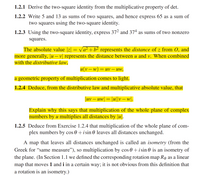
Advanced Engineering Mathematics
10th Edition
ISBN: 9780470458365
Author: Erwin Kreyszig
Publisher: Wiley, John & Sons, Incorporated
expand_more
expand_more
format_list_bulleted
Question
thumb_up100%
Please help with 1.2.4 (highlighted) for Modern ALgebra
Thankyou so much

Transcribed Image Text:1.2.1 Derive the two-square identity from the multiplicative property of det.
1.2.2 Write 5 and 13 as sums of two squares, and hence express 65 as a sum of
two squares using the two-square identity.
1.2.3 Using the two-square identity, express 372 and 37ª as sums of two nonzero
squares.
The absolute value |z| = va² +b² represents the distance of z from 0, and
more generally, |u – v| represents the distance between u and v. When combined
with the distributive law,
Z.
u(v – w)
= uv – Uw,
a geometric property of multiplication comes to light.
1.2.4 Deduce, from the distributive law and multiplicative absolute value, that
|uv – uw = |u||v – w|.
Explain why this says that multiplication of the whole plane of complex
numbers by u multiplies all distances by |u|.
1.2.5 Deduce from Exercise 1.2.4 that multiplication of the whole plane of com-
plex numbers by cos 0+ i sin 0 leaves all distances unchanged.
A map that leaves all distances unchanged is called an isometry (from the
Greek for "same measure"), so multiplication by cos 0 +isin 0 is an isometry of
the plane. (In Section 1.1 we defined the corresponding rotation map Re as a linear
map that moves 1 and i in a certain way; it is not obvious from this definition that
a rotation is an isometry.)
Expert Solution
This question has been solved!
Explore an expertly crafted, step-by-step solution for a thorough understanding of key concepts.
This is a popular solution
Trending nowThis is a popular solution!
Step by stepSolved in 2 steps with 2 images

Knowledge Booster
Similar questions
arrow_back_ios
arrow_forward_ios
Recommended textbooks for you
 Advanced Engineering MathematicsAdvanced MathISBN:9780470458365Author:Erwin KreyszigPublisher:Wiley, John & Sons, Incorporated
Advanced Engineering MathematicsAdvanced MathISBN:9780470458365Author:Erwin KreyszigPublisher:Wiley, John & Sons, Incorporated Numerical Methods for EngineersAdvanced MathISBN:9780073397924Author:Steven C. Chapra Dr., Raymond P. CanalePublisher:McGraw-Hill Education
Numerical Methods for EngineersAdvanced MathISBN:9780073397924Author:Steven C. Chapra Dr., Raymond P. CanalePublisher:McGraw-Hill Education Introductory Mathematics for Engineering Applicat...Advanced MathISBN:9781118141809Author:Nathan KlingbeilPublisher:WILEY
Introductory Mathematics for Engineering Applicat...Advanced MathISBN:9781118141809Author:Nathan KlingbeilPublisher:WILEY Mathematics For Machine TechnologyAdvanced MathISBN:9781337798310Author:Peterson, John.Publisher:Cengage Learning,
Mathematics For Machine TechnologyAdvanced MathISBN:9781337798310Author:Peterson, John.Publisher:Cengage Learning,


Advanced Engineering Mathematics
Advanced Math
ISBN:9780470458365
Author:Erwin Kreyszig
Publisher:Wiley, John & Sons, Incorporated

Numerical Methods for Engineers
Advanced Math
ISBN:9780073397924
Author:Steven C. Chapra Dr., Raymond P. Canale
Publisher:McGraw-Hill Education

Introductory Mathematics for Engineering Applicat...
Advanced Math
ISBN:9781118141809
Author:Nathan Klingbeil
Publisher:WILEY

Mathematics For Machine Technology
Advanced Math
ISBN:9781337798310
Author:Peterson, John.
Publisher:Cengage Learning,

